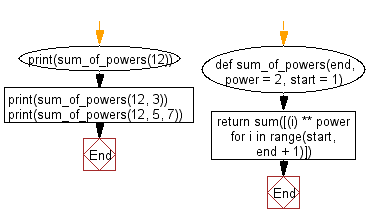Python Math: Get the sum of the powers of all the numbers from start to end (both inclusive)
Python Math: Exercise-85 with Solution
Write a Python program to get the sum of the powers of all the numbers from start to end (both inclusive).
- Use range() in combination with a list comprehension to create a list of elements in the desired range raised to the given power.
- Use sum() to add the values together.
- Omit the second argument, power, to use a default power of 2.
- Omit the third argument, start, to use a default starting value of 1.
Sample Solution:
Python Code:
def sum_of_powers(end, power = 2, start = 1):
return sum([(i) ** power for i in range(start, end + 1)])
print(sum_of_powers(12))
print(sum_of_powers(12, 3))
print(sum_of_powers(12, 5, 7))
Sample Output:
650 6084 618507
Flowchart:

Visualize Python code execution:
The following tool visualize what the computer is doing step-by-step as it executes the said program:
Python Code Editor:
Have another way to solve this solution? Contribute your code (and comments) through Disqus.
Previous: Write a Python program to get the nth tetrahedral number from a given integer(n) value.
Next: Write a Python program to calculate the Hamming distance between two given values.
What is the difficulty level of this exercise?
Test your Programming skills with w3resource's quiz.
Python: Tips of the Day
Find current directory and file's directory:
To get the full path to the directory a Python file is contained in, write this in that file:
import os dir_path = os.path.dirname(os.path.realpath(__file__))
(Note that the incantation above won't work if you've already used os.chdir() to change your current working directory, since the value of the __file__ constant is relative to the current working directory and is not changed by an os.chdir() call.)
To get the current working directory use
import os cwd = os.getcwd()
Documentation references for the modules, constants and functions used above:
- The os and os.path modules.
- The __file__ constant
- os.path.realpath(path) (returns "the canonical path of the specified filename, eliminating any symbolic links encountered in the path")
- os.path.dirname(path) (returns "the directory name of pathname path")
- os.getcwd() (returns "a string representing the current working directory")
- os.chdir(path) ("change the current working directory to path")
Ref: https://bit.ly/3fy0R6m
- New Content published on w3resource:
- HTML-CSS Practical: Exercises, Practice, Solution
- Java Regular Expression: Exercises, Practice, Solution
- Scala Programming Exercises, Practice, Solution
- Python Itertools exercises
- Python Numpy exercises
- Python GeoPy Package exercises
- Python Pandas exercises
- Python nltk exercises
- Python BeautifulSoup exercises
- Form Template
- Composer - PHP Package Manager
- PHPUnit - PHP Testing
- Laravel - PHP Framework
- Angular - JavaScript Framework
- Vue - JavaScript Framework
- Jest - JavaScript Testing Framework
